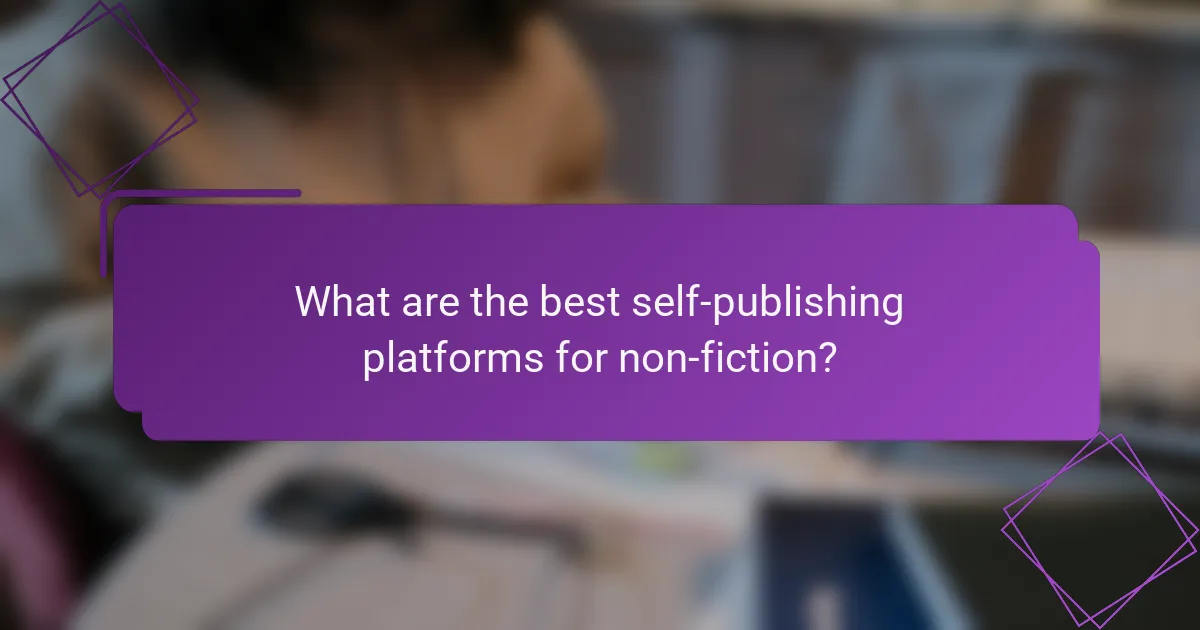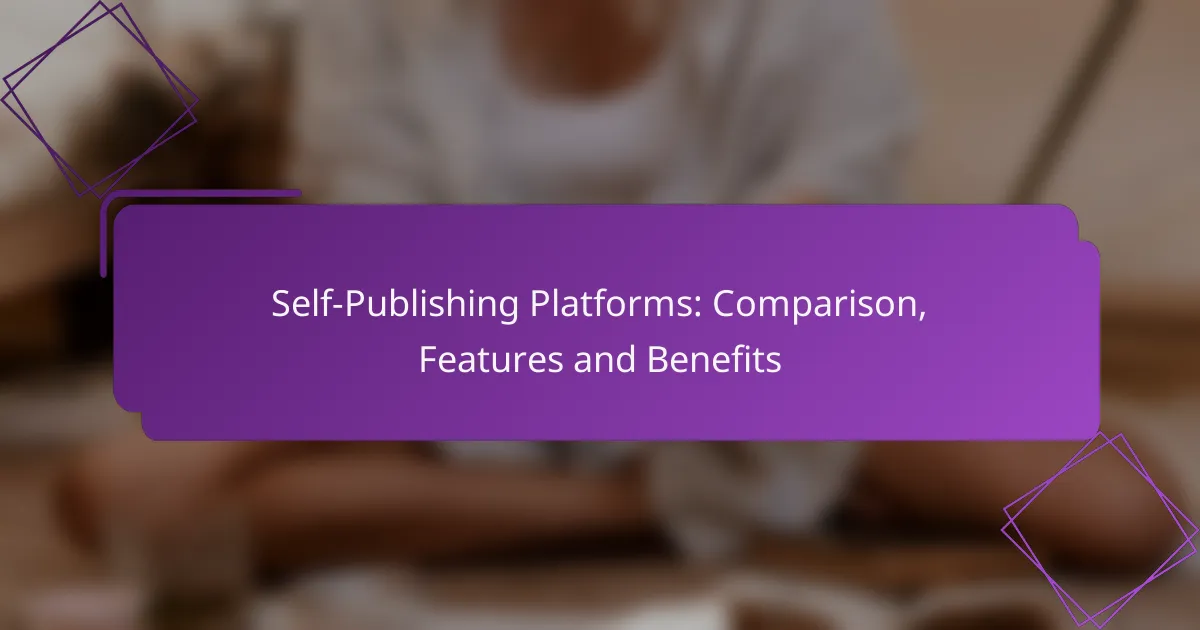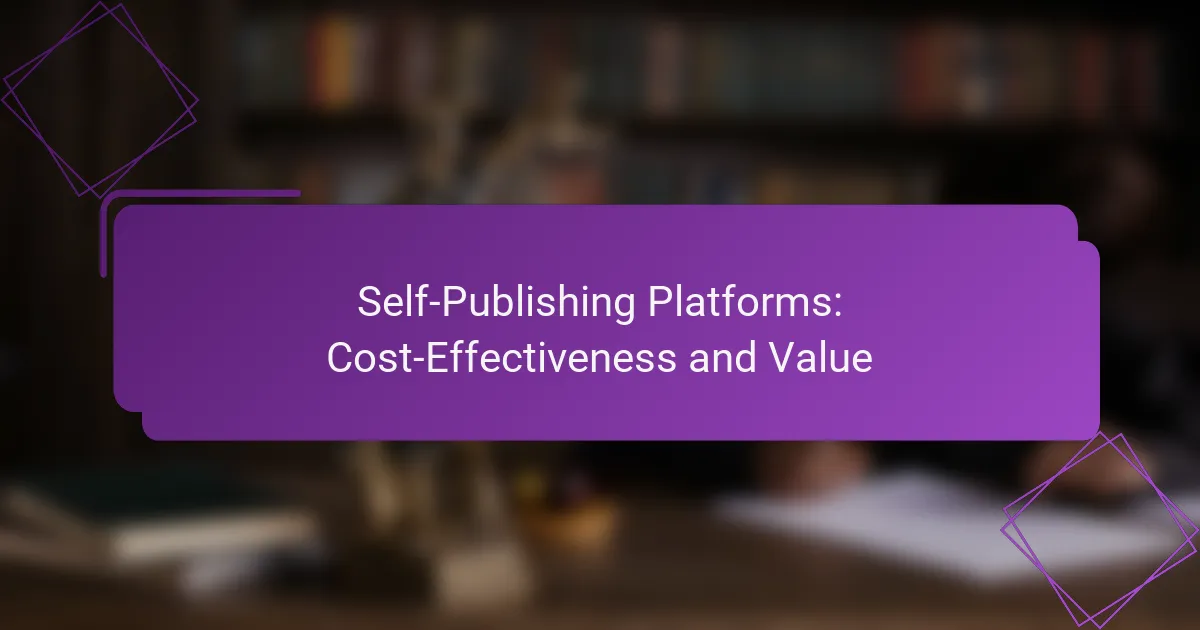Self-publishing platforms have become essential for authors of both fiction and non-fiction, providing valuable tools and distribution options to connect with readers. When choosing a platform, it’s important to consider factors such as ease of use, royalty rates, and audience reach. Additionally, user feedback plays a crucial role in shaping an author’s reputation and influencing sales, making it vital to pay attention to reviews and ratings.

What are the best self-publishing platforms for fiction?
The best self-publishing platforms for fiction offer authors a range of tools and distribution options to reach readers effectively. Key considerations include ease of use, royalties, and the potential audience each platform can access.
Amazon Kindle Direct Publishing
Amazon Kindle Direct Publishing (KDP) is one of the most popular platforms for self-publishing fiction. It allows authors to publish eBooks and paperbacks, reaching millions of readers on Amazon. Authors can earn up to 70% royalties on eBooks priced between $2.99 and $9.99.
To get started, authors simply need to create an Amazon account, upload their manuscript, and set their pricing. KDP also offers promotional tools like Kindle Countdown Deals and Free Book Promotions to boost visibility.
Smashwords
Smashwords is a versatile platform that distributes eBooks to major retailers and libraries, including Barnes & Noble and Apple Books. It offers authors the ability to set their own prices and earn up to 80% royalties on sales through its own store.
Authors can format their manuscripts using Smashwords’ Style Guide, which helps ensure compatibility across various eBook formats. This platform is ideal for authors looking to maximize their reach without being tied to a single retailer.
Draft2Digital
Draft2Digital simplifies the self-publishing process by providing a user-friendly interface and automatic formatting for eBooks. It distributes to multiple retailers, including Amazon, Kobo, and Apple Books, allowing authors to reach a wide audience.
Authors can earn around 60% royalties on sales, and Draft2Digital does not charge upfront fees. The platform also offers useful tools like free ISBNs and the ability to create print books, making it a comprehensive choice for fiction writers.
IngramSpark
IngramSpark is a powerful platform for authors looking to publish print books and eBooks with global distribution. It connects authors to Ingram’s extensive network of bookstores and libraries, which is crucial for gaining physical shelf space.
While IngramSpark charges setup fees, authors can benefit from higher visibility and potentially larger sales. The platform also offers promotional options and print-on-demand services, making it suitable for serious authors aiming for traditional retail markets.
Apple Books
Apple Books allows authors to publish and sell their eBooks directly to Apple users, leveraging the vast ecosystem of Apple devices. Authors can set their own prices and earn royalties of around 70% on sales.
To publish on Apple Books, authors need to use the Apple Books for Authors platform, which provides tools for formatting and marketing. This platform is particularly beneficial for authors targeting readers within the Apple ecosystem, especially in regions where Apple has a strong market presence.

What are the best self-publishing platforms for non-fiction?
The best self-publishing platforms for non-fiction offer authors a range of tools and distribution options to reach their audience effectively. Key considerations include ease of use, royalty rates, and the ability to format and market your work.
Amazon Kindle Direct Publishing
Amazon Kindle Direct Publishing (KDP) is one of the most popular platforms for self-publishing non-fiction. It allows authors to publish eBooks and paperbacks for free, with royalties ranging from 35% to 70% depending on the pricing strategy. KDP provides access to a vast audience through Amazon’s marketplace, making it an attractive option for many authors.
When using KDP, ensure your book is well-formatted and has an eye-catching cover. Take advantage of Amazon’s promotional tools, such as Kindle Countdown Deals, to increase visibility and sales.
Smashwords
Smashwords is a versatile platform that distributes eBooks to various retailers, including Apple Books and Barnes & Noble. Authors can set their own prices and earn royalties of up to 80% on sales through Smashwords’ own store. This platform is particularly beneficial for authors looking to reach multiple markets without the hassle of managing each one individually.
To maximize your success on Smashwords, follow their formatting guidelines closely and consider enrolling in their Premium Catalog for wider distribution. Regularly update your book’s metadata to improve discoverability.
IngramSpark
IngramSpark is a robust platform for authors wanting to publish both print and eBooks. It offers extensive distribution options, reaching libraries and bookstores globally. While there is a setup fee, the potential for wider reach can justify the cost, especially for non-fiction authors targeting niche markets.
When using IngramSpark, ensure that your book meets industry standards for print quality. Consider using their promotional offers to waive setup fees, making it more cost-effective to launch your book.
BookBaby
BookBaby provides a comprehensive suite of services for self-publishing non-fiction, including editing, design, and marketing. Authors can choose from various packages that suit their needs, with royalties typically around 100% on sales through their store. This platform is ideal for authors seeking a hands-off approach to publishing.
Before selecting BookBaby, evaluate the services included in each package to ensure they align with your goals. Take advantage of their marketing resources to effectively promote your book post-launch.
Blurb
Blurb specializes in creating visually appealing books, making it an excellent choice for non-fiction authors with a strong visual component, such as cookbooks or art books. Authors can create print books and eBooks with a focus on design, and they can sell directly through Blurb’s platform or distribute to retailers.
To get the most out of Blurb, utilize their free design tools to create a professional-looking book. Consider offering a preview of your book online to attract potential buyers before the official launch.

How do user reviews impact self-publishing platforms?
User reviews significantly influence self-publishing platforms by affecting both sales and author reputation. Positive feedback can lead to increased visibility and trust, while negative reviews may deter potential readers and impact an author’s credibility.
Influence on sales
User reviews play a crucial role in driving sales on self-publishing platforms. Books with higher ratings and numerous positive reviews are more likely to attract buyers, as readers often rely on the experiences of others to make purchasing decisions.
A study of various platforms shows that titles with an average rating of four stars or higher tend to sell significantly better than those with lower ratings. Authors should actively encourage readers to leave reviews to enhance their book’s marketability.
Impact on author reputation
User reviews can shape an author’s reputation in the literary community. Consistent positive feedback builds credibility, while negative reviews can tarnish an author’s image, making it essential to manage and respond to feedback thoughtfully.
Authors should consider engaging with reviewers, thanking them for positive comments, and addressing concerns raised in negative reviews. This interaction can demonstrate professionalism and a willingness to improve, which can positively influence potential readers.
Role in platform selection
User reviews can also guide authors in choosing the right self-publishing platform. Platforms with a strong reputation for supporting authors and providing a positive user experience often have better reviews, which can be a deciding factor for new authors.
When selecting a platform, authors should research user feedback regarding ease of use, customer service, and distribution options. Comparing reviews across different platforms can help authors make informed decisions that align with their publishing goals.

What are the key features to consider in a self-publishing platform?
When choosing a self-publishing platform, consider features such as distribution options, royalty rates, user interface, and customer support. These elements significantly impact your publishing experience and potential earnings.
Distribution options
Distribution options determine where and how widely your book will be available. Many platforms offer global distribution, allowing your work to reach major retailers like Amazon, Barnes & Noble, and Apple Books, while others may focus on specific regions or formats.
Evaluate whether the platform provides options for both eBooks and print books, as well as access to libraries and educational institutions. A wider distribution network can enhance your book’s visibility and sales potential.
Royalty rates
Royalty rates represent the percentage of sales you earn from your book. Most self-publishing platforms offer rates ranging from 35% to 70% for eBooks, depending on factors like pricing and distribution channels.
For print books, royalty rates are often lower, typically between 40% and 60%. Be sure to read the fine print regarding any additional costs, such as printing fees, which can affect your overall earnings.
User interface
A user-friendly interface is crucial for a smooth publishing process. Look for platforms that provide intuitive tools for formatting, cover design, and manuscript upload, making it easier to navigate the self-publishing journey.
Consider platforms that offer templates and step-by-step guides to assist you in creating a professional-looking book. A well-designed interface can save you time and reduce frustration during the publishing process.
Customer support
Reliable customer support is essential when you encounter issues or have questions about the self-publishing process. Check if the platform offers multiple support channels, such as email, chat, or phone assistance.
Look for platforms with responsive support teams and comprehensive FAQs or knowledge bases. Good customer support can significantly enhance your experience and help you resolve problems quickly.



